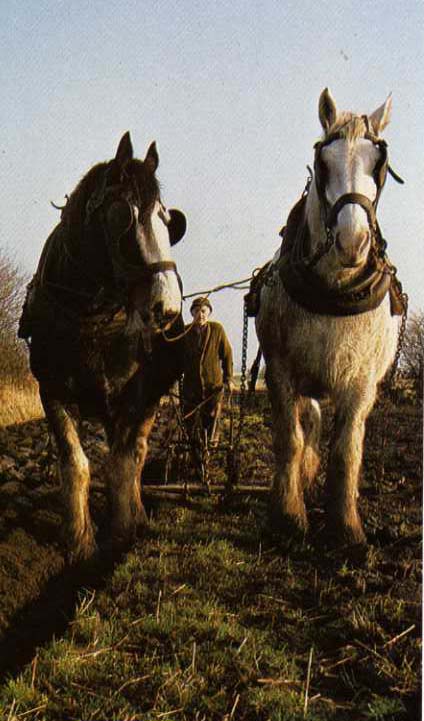Horses have been
known in Western Europe since the end of the last ice age, the concept
of riding or using the horse for draught purposes appears only to
have occurred to man about four thousand years ago on the Eurasian
steppes, and spread slowly to the rest of the world, previously
they had just been eaten.
The earliest remains of horses found in the
area now covered by Britain and Ireland date back to 700,000 BC.
A horse shoulder bone dating to 500,000 BC found in a gravel pit
in Sussex (England) had a score caused by a flint spear, proving
that early man hunted horses in this period.
Ireland today has a population of about 60,000
horses of which something over 25% are race horses. (Note: These
figures are not recent)
The horse first appeared in Ireland about two thousand five hundred
BC, brought here by stone age farmers. Little is known as to exactly
how these people utilized the horse. The Celtic tribes arrived around
six hundred BC bringing with them not only their horses but also
the chariot, the Celts venerated the horse and it featured prominently
in their folklore and culture. The horse has assisted man to create
the landscape we see today, it has been used within living memory
to plough and cultivate the land for food production, in warfare
it carried man into battle, and hauled his cannons across the land.
horse first appeared in Ireland about two thousand five hundred
BC, brought here by stone age farmers. Little is known as to exactly
how these people utilized the horse. The Celtic tribes arrived around
six hundred BC bringing with them not only their horses but also
the chariot, the Celts venerated the horse and it featured prominently
in their folklore and culture. The horse has assisted man to create
the landscape we see today, it has been used within living memory
to plough and cultivate the land for food production, in warfare
it carried man into battle, and hauled his cannons across the land.
The arrival of the Normans in the late 1100's
added further to the gene pool of the Irish horse. Another injection
of foreign genes may have taken place in 1588 when some twenty-three
ships of the Spanish Armada were wrecked on the Irish coast, many
of these ships would have been carrying horses, and it seems entirely
conceivable that some may have survived and made their way ashore,
and unlike surviving seamen would not have been slaughtered.
Exactly what gives Irish horses their edge
is unclear no doubt it is due largely to the skill of the stud farmers,
acquired over generations. Some say it is the minerals in the grass
which in places such as the Curragh of Kildare is set upon limestone,
these minerals may improve and strengthen the bone structure of
the horse.
The power and grace of the Irish horse has
long been admired and sought after, in the 18th and 19th centuries
quartermasters from France and Russia visited Irish horse fairs
in search of mounts for their elite cavalry regiments. Many such
horse fairs are held throughout Ireland one such and probably the
largest is held each October at Ballinasloe
County Galway, in the past as many as 4,000 animals would have change
hands in a day. Check our county
events and fairs and
shows pages.
Napoleon's favourite horse Marengo is said
to have been bought at the horse fair at Ballinasloe, County Galway.
|